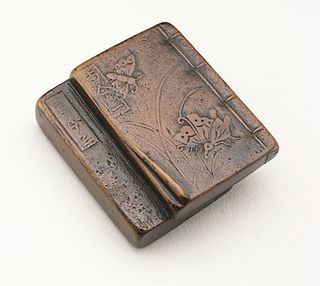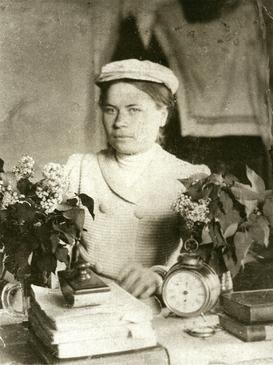Related Research Articles

Haiku is a type of short form poetry that originated in Japan, and can be traced back from the influence of traditional Chinese poetry. Traditional Japanese haiku consist of three phrases composed of 17 morae in a 5, 7, 5 pattern; that include a kireji, or "cutting word"; and a kigo, or seasonal reference. However, haiku by classical Japanese poets, such as Matsuo Bashō, also deviate from the 17-on pattern and sometimes do not contain a kireji. Similar poems that do not adhere to these rules are generally classified as senryū.

Pärnu is the fourth-largest city in Estonia. Situated in southwest Estonia, Pärnu is located 128 kilometres (80 mi) south of the Estonian capital, Tallinn, and 176 kilometres (109 mi) west of Estonia's second-largest city, Tartu. The city sits off the coast of Pärnu Bay, an inlet of the Gulf of Riga, which is a part of the Baltic Sea. In the city, the Pärnu River drains into the Gulf of Riga.

Japanese poetry is poetry typical of Japan, or written, spoken, or chanted in the Japanese language, which includes Old Japanese, Early Middle Japanese, Late Middle Japanese, and Modern Japanese, as well as poetry in Japan which was written in the Chinese language or ryūka from the Okinawa Islands: it is possible to make a more accurate distinction between Japanese poetry written in Japan or by Japanese people in other languages versus that written in the Japanese language by speaking of Japanese-language poetry. Much of the literary record of Japanese poetry begins when Japanese poets encountered Chinese poetry during the Tang dynasty. Under the influence of the Chinese poets of this era Japanese began to compose poetry in Chinese kanshi); and, as part of this tradition, poetry in Japan tended to be intimately associated with pictorial painting, partly because of the influence of Chinese arts, and the tradition of the use of ink and brush for both writing and drawing. It took several hundred years to digest the foreign impact and make it an integral part of Japanese culture and to merge this kanshi poetry into a Japanese language literary tradition, and then later to develop the diversity of unique poetic forms of native poetry, such as waka, haikai, and other more Japanese poetic specialties. For example, in the Tale of Genji both kanshi and waka are frequently mentioned. The history of Japanese poetry goes from an early semi-historical/mythological phase, through the early Old Japanese literature inclusions, just before the Nara period, the Nara period itself, the Heian period, the Kamakura period, and so on, up through the poetically important Edo period and modern times; however, the history of poetry often is different from socio-political history.
Haibun is a prosimetric literary form originating in Japan, combining prose and haiku. The range of haibun is broad and frequently includes autobiography, diary, essay, prose poem, short story and travel journal.

Gabriel Rosenstock is an Irish writer who works chiefly in the Irish language. A member of Aosdána, he is a poet, playwright, haikuist, tankaist, essayist, and author/translator of over 180 books, mostly in Irish. Born in Kilfinane, County Limerick, he currently resides in Dublin.

Elo Viiding is an Estonian poet and prose writer.

Anatoly Kudryavitsky is a Russian-Irish novelist, poet, editor and literary translator.

Estonian literature is literature written in the Estonian language
Hisaye Yamamoto was an American author known for the short story collection Seventeen Syllables and Other Stories, first published in 1988. Her work confronts issues of the Japanese immigrant experience in America, the disconnect between first and second-generation immigrants, as well as the difficult role of women in society.

Vahur Afanasjev was an Estonian novelist, poet, musician and film director best known for his novel Serafima and Bogdan a story following the lives in a village of Russian Orthodox Old Believers on the shore of the lake Peipus from the end of the World War II to the nineties. The novel won the 2017 Estonian Writers' Union's Novel Competition.
A haiku in English is an English-language poem written in a form or style inspired by Japanese haiku. Like their Japanese counterpart, haiku in English are typically short poems and often reference the seasons, but the degree to which haiku in English implement specific elements of Japanese haiku, such as the arranging of 17 phonetic units in a 5–7–5 pattern, varies greatly.

Karl Martin Sinijärv is an Estonian journalist and poet.

Rein Raud is an Estonian academic and author.
The composition and translation of tanka in English begins at the end of the nineteenth century in England and the United States. Translations into English of classic Japanese tanka date back at least to the 1865 translation of the classic Ogura Hyakunin Isshu ; an early publication of originally English tanka dates to 1899. In the United States, the publication of tanka in Japanese and in English translation acquired extra impetus after World War II and was followed by a rise of the genre's popularity among native speakers of English.

Asko Künnap is an Estonian designer, writer, and artist.
The Japanese haiku has been adopted in various languages other than Japanese.

Marie Heiberg was an Estonian poet. When she was only about 15 years old she wrote her first poems which were acclaimed for their youthful freshness. Heiberg spent the last twenty years of her life in a mental institution. There is a memorial to her memory in Urvaste.

Kätlin Kaldmaa is an Estonian freelance writer, poet, translator and literary critic. Since 2010, Kaldmaa is the president of the Estonian PEN. In 2016 she was elected Secretary of the PEN International.
Estonian Poetry is poetry written in the Estonian language or in Estonia.

Sino-Uralic or Sino-Finnic is a long-range linguistic proposal that links the Sinitic languages (Chinese) and the Uralic languages. Sino-Uralic is proposed as an alternative to the Sino-Tibetan family and is at odds with mainstream comparative linguistics, which firmly includes the Sinitic languages in the Sino-Tibetan family. The proposal has been brought forward by the Chinese linguist Jingyi Gao, based on works by 19th century linguists such as Karl August Hermann. However, connections with the Uralic and other language families are generally seen as speculative.
References
- ↑ Eesti haiku trohheuse ja muude loomadega Archived 2013-12-27 at the Wayback Machine . Sirp, Maarja Kangro, 2010. Issue 23 (3303)
- ↑ Koht ja paik. Eesti Kunstiakadeemia, 2004. Issues 4-5
- ↑ "Munster Literature Centre". Archived from the original on 2015-09-18. Retrieved 2015-11-10.
- ↑ Shamrock Haiku Journal No 3, 2007